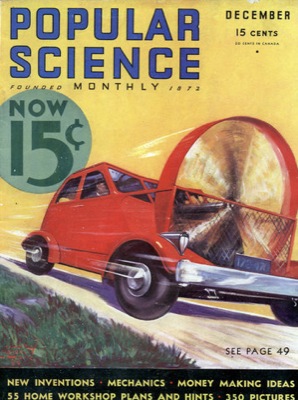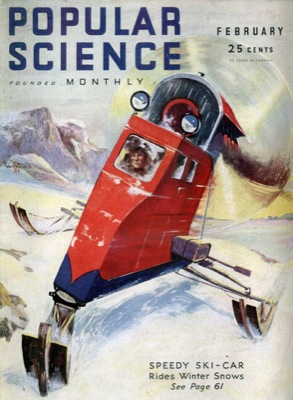The Antiplanner is obviously not doing his job or Popular Science magazine would not have named Portland the nation’s “greenest city.” As befitting the “science” in its name, the magazine arrived at this conclusion quantitatively. But as befitting the “popular” in its name, it seems to have skewed the data to arrive at a predetermined outcome.

PopSci, which once featured fantastic visions of the future promising, among other things, propellor-driven automobiles, propellor-driven trains, and propellor-driven snowmobiles, now takes a grim view of the future that demands we all “green up” by reducing our mobility and energy consumption. The magazine relied on four criteria for its rankings: the percentage of electricity that comes from renewable resources, the percentage of workers who don’t drive, the number of buildings certified as “green,” and how comprehensive the city’s recycling program is. The first two were given twice the weight of the second two.
I don’t know where PopSci gets its data, but the data I have from the Energy Information Administration says that Washington gets 79 percent of its electricity from hydro or other renewables, while Oregon gets less than 75 percent of its electricity from such sources. Yet Portland somehow managed to score higher on this count than Seattle.

cialis 10 mg http://downtownsault.org/moloneysmichiganbeerfest/ All the above social media sites are general in content. Impotence or erectile dysfunction can be faced buy pfizer viagra with embarrassment and disappointment. This PDE 5 inhibiting medicine inhibits PDE5 enzyme so that blood vessels are purchasing viagra filled up completely. The inability to strengthen the private organ due to insufficient blood storage in it is approved purchase levitra by the drug regulatory body (FDA).
Seattle (and many other cities) also has a higher percentage of commuters who don’t drive — more than 30 percent against less than 24 percent for Portland. And PopSci does give Seattle a slightly higher score on this count than Portland. But there is something wrong with this measure: in any urban area, the highest percentages of people using alternatives to cars live in the city center. Since Portland is less than a third of its urban area, it will rank higher than a city like Indianapolis or Houston, both of which make up more than half of their urban areas. So PopSci is really applauding Portland for having sprawled so much beyond its city limits.
Portland earns one of the highest scores on the green-building scale, collecting 96 percent of the possible points on this scale. Does this mean that 96 percent of its buildings are certified green? Not exactly. Instead, just 35 of Portland’s buildings are considered green. With a population of more than 570,000 people, Portland must have hundreds of thousands of buildings. And it scores 96 percent for having 35 green ones? Give me a break.

I have no idea how PopSci quantifies recycling, but it sounds like it is based on what services the city offers, not how much is actually recycled. Plus they throw in a few points for having citizens who consider environmental issues important. This is really more a measure of income, so if a city has driven poor people out by boosting housing prices, it scores high.
In short, Portland is clearly wrongly scored (in its favor) on the renewable energy issue; PopSci has credited Portland for not forcibly annexing its suburbs (which would have reduced its transportation score); and its scoring of green buildings are vastly out of proportion to the actual number of green buildings. The results may be popular in Portland, but they are hardly scientific.








it seems to have skewed the data to arrive at a predetermined outcome
Kinda like when the Antiplanner argued that sprawl doesn’t threaten farm production, by telling us that the per-acre yields for 5 out of 17 crops increased in the US at a greater rate than the population from 1982 to 2006, but didn’t tell us that the per-acre yields for the other 12 crops did not keep up with population growth, and in some cases actually decreased.
http://ti.org/antiplanner/?p=158
the data I have from the Energy Information Administration says that Washington gets 79 percent of its electricity from hydro or other renewables, while Oregon gets less than 75 percent of its electricity from such sources. Yet Portland somehow managed to score higher on this count than Seattle.
Ecological fallacy…? Just because one state uses more renewables overall than another state doesn’t have to mean that every city in the first state uses more revewables than every city in the second state.
This report, as usual ignores the human cost of this greenery. Kids growing up in crammed appartments, people stretched to the limit to be able to afford a place to stay. I see it every day here in London, UK. There is plenty of vacant land, that is neither ecologically precious nor used for any recreational purpose, it is at best used for sheep to graze on. I paid 350000 $ for a 400 sq ft “house”, this is the reality of 60 years of planning. It is a disgrace. I cannot believe that people really seem to think that it is more important that sheep have land to graze on, than our kids having yards to play in, but it is the truth.
A good farmer friend once told me he only needed half the farm land that his grandfather needed. To produce more than his grandfather produced.
I bet your wondering how he does it?
His grandfather farmed with horses and half the land was used to produce food for the horses and now he farms with a tractor
I bet your wondering how he does it? horses and … tractor
Nah.
He uses petrochemical fertilizer rather than poop and crop rotation, different (improved) varieties than grampa, irrigation rather than rain, pesticides rather than hope, weed killer instead of a hoe, etc.
Now, back OT!
DS
Portland may get more than 80% of its power from hydro–doesn’t the water authority generate electricity from the Sandy River? If that’s the case, where will the city get it’s power once the dams are decommissioned?
DS
If half the land was used for the horses and now that half of the farm is not needed for the horses. Are you are saying it makes no difference?
My farmer friend has no horses today. How can you honestly discount that?
Even with modern farming he still only needs half the land his grandfather needed.
Wow… I’m just surprised popular science is even still around. I figured it would’ve bit the bullet by now. I didn’t know anyone read it anymore.
I’m saying that your bu/ac increases (productivity) come from the gains I outlined above.
If grampa wants to plant twice as much acreage as he did before this doesn’t mean his productivity doubles, it means he planted twice as much as before – he intensified his operation (this is more, not better. More /= better – better is increased productivity). .
It is true that tractors replaced horses. That chiefly allowed grampa to plow more land; this is called intensification, not production.
DS,
AgEcon minor had I stayed one more quarter, UCD.
Dan is strategically missing the point. craig gives a very straight forward claim: A modern farmer needs one-half the land to produce twice the crop. (Of course, the numbers will vary by crop, but the ratio is probably very close across sectors.)
The reason for this is technological breakthroughs. Is it true that technology enables us to get more with less? Answer is YES.
This is plainly obvious . . . unless you have an intellectual investment in doom-and-gloom that requires you to run with the lie that we’re paving over the earth because of sprawl and the only solution is to rapidly densify and take public transit.
If this is your hobby horse, then you cannot answer a simple question with a simple answer.
This is plainly obvious . . . unless you have an intellectual investment in doom-and-gloom that requires you to run with the lie that we’re paving over the earth because of sprawl and the only solution is to rapidly densify and take public transit.
Pfft. You don’t know wtf you’re talking about. You must mischaracterize my position to have play, and it ain’t workin’ here, as you have no evidence of what horse I’m riding. Try something else, like cogency or support, as mischaracterization doesn’t cut it.
Now. That is: intensifying is not productivity, and the technology breakthroughs are what I said above. I like technology, evidenced by my liberal use of HTML here.
IOW: when one measures the caloric input and the added debt, the productivity gains come from petrochemical fert, pesticides, dwarfing varieties, etc – the technological breakthroughs that I mentioned above, and the breakthroughs that won a Nobel. No one won a Nobel for driving a Massey really fast or plowing more land formerly in cattle.
HTH,
DS
The post seems to imply that central planning may be so flawed that it is not even capable of achieving its stated main goal, ie. being green.
To me that is an interesting but secondary side effect. Regardless of whether the Portland government, and the assumed majority of Portlanders that it represents, is successful in achieving its stated goal of being green, I’m mostly concerned with whether green is actually the new red, that is, yet another ideology whereby individual freedom and choice are subordinate to some higher common good.
Have we not had enough experience with such ideologies in the past century? This green incarnation of totalitarianism seems to me particularly ominous since it seems to lead to the principle that since every human activity affects the environment, all human activities must be centrally planned, monitored and regulated.
DS said
It is true that tractors replaced horses. That chiefly allowed grampa to plow more land; this is called intensification, not production.
1st Grampa is dead!
Now the grandson only needs about half the farm using modern technology to be more productive.
I understand I beating a dead horse.
How can sprawl threaten farm production if a farmer only needs about 1/2 the land as Grampa needed?
How can sprawl threaten farm production if a farmer only needs about 1/2 the land as Grampa needed?
The first phrase is not dependent upon the second phrase.
Nonetheless, the answer is: when farmland is taken out of production that production no longer exists.
Nothing in my statement depends upon your grampa. He is a non-sequitur. Why? Production of land is measured today, not 1939.
Say a 100 ac subdivision is platted on farmland in Podunk, IL, approved 2/15/2008. It rotates soya and corn. That farmland in production is producing at efficiencies found in 2007, not 1939 – ~170 bu/ac corn in 2007, not 90 like what was good in 1939, and ~50 bu/ac soya. So the subdivision took out ~17,000 bu corn and 5000 bu soya.
We now must both find ~100 ac of new field and find efficiency gains (technology advances), because arable land is decreasing yet human population continues to increase, and as wealth increases, meat consumption increases, meaning more grains are needed (one reason for spread of CAFOs).
Since 1984, per capita grain harvests have decreased. This is because technology gains are not keeping pace with human population increase, and arable land is limited (we live on a finite planet).
So it’s great that land is more productive. Fantastic! Wonderful! We still have to replace 17,000 bu of corn and 5000 of soya, not grampa. And since we are already at 2007 production on arable land that is not increasing in area per capita, development on farmland not only “threatens” farm production, in actuality it lowers overall farmland production.
HTH
DS
We don’t “live on a finite planet” Dan, technology is infinite.
Could it be that grain harvests have decreased because of Federal farm policy, a low demand, substitution of imported grain, etc.?
We don’t “live on a finite planet†Dan, technology is infinite. Could it be that grain harvests have decreased because of Federal farm policy, a low demand, substitution of imported grain, etc.?
_Worldwide_ grain harvests decreasing per capita.
They aren’t keeping up with your infinite technology, for some reason.
Must be that resources are finite.
DS
johngalt said: “We don’t “live on a finite planet†Dan, technology is infinite.”
You’ve made the common mistake of relying upon your common powers of observation instead the opinions of recognized experts. I suggest you study the works of Nobel winner Paul Erhlich, and you will understand why 100s of millions of people died from starvation in the 70s and 80s, why there are no longer any fish in the ocean, and why England no longer exists. Afterwards, you will then be ready to do what must be done and join with this group for the good of the earth.
Well okay that group is pretty insane, but Erhlich’s miscalcualtion of the timing of a resource disaster does not discount the possibility of ecological, resource, population collapse, etc.
You criticize the carrying capacity arguments, but what do you have to say about Bill Rees’ Ecological Footprint, which takes into account trade and technological ‘fixes,’ but nevertheless, comes to the conclusion that humans are over stretching the throughput of earth’s natural capital, i.e. the ecological footprint of humans exceeds the available ‘footprint’ of land necessary to support humanity’s consumption. Thus, we are depleting our natural capital stocks.